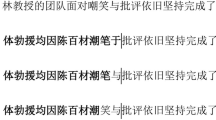Abstract
The size and shape of the effective visual field in Chinese reading was investigated by systematically manipulating the availability of meaningful information on both sides of a fixated character. A self-paced, moving-window technique (Chen 1992) was adopted to measure the viewing time of individual characters as an on-line indicator of reading effectiveness under various display conditions. The results showed that the effective visual field in reading Chinese was asymmetric and skewed in the direction of scanning with a highly limited size, composing of the fixated character and two characters to its right.
Access this chapter
Tax calculation will be finalised at checkout
Purchases are for personal use only
Preview
Unable to display preview. Download preview PDF.
Similar content being viewed by others
References
Chen, H-C. (1992). Reading comprehension in Chinese: Implications from character reading times. In: Chen, H-C. & Tzeng, O.J.L. (eds.), Language processing in Chinese (pp. 175–205 ). Amsterdam: North-Holland.
Chen, H-C. (1996). Chinese reading and comprehension: A cognitive psychology perspective. In Bond, M.H. (ed.), The handbook of Chinese psychology (pp. 43–62 ). Hong Kong: Oxford University Press.
Chen, H-C. (in press). How do readers of Chinese process words during reading for comprehension. In Wang, J., Inhoff, A.W. & Chen, H-C. (eds.), Reading Chinese script: A cognitive analysis. Mahwah, NJ: Erlbaum.
Chen, H-C. & Chen, M.J. (1988). Directional scanning in Chinese reading. In Liu, I-M., Chen H-C. & Chen, M.J. (eds.), Cognitive aspects of the Chinese language (pp. 15–26 ). Hong Kong: Asian Research Services.
Hoosain, R. (1991). Psycholinguistic implications for linguistic relativity: A case study of Chinese. Hillsdale, NJ: Erlbaum.
Ikeda, M. & Saida, S. (1978). Span of recognition in reading, Vision Research 18: 83–88.
Inhoff, A.W. & Liu, W. M. (1997). The range of effective vision during the reading of Chinese sentences. In Chen, H-C. (ed.), The cognitive processing of Chinese and related Asian languages (pp. 243–265 ). Hong Kong: Chinese University Press.
Just, M.A., Carpenter, P.A. & Woolley, J.D. (1982). Paradigms and processes in reading comprehension, Journal of Experimental Psychology: General 111: 228–238.
McConkie, G.W. & Rayner, K. (1975). The span of the effective stimulus during a fixation in reading, Perception and Psychophysics 17: 578–586.
McConkie, G.W. & Rayner, K. (1976). Asymmetry of the perceptual span in reading, Bulletin of the Psychonomic Society 8: 365–368.
O'Regan, J.K. (1979). Eye guidance in reading: Evidence for the linguistic control hypothesis, Perception and Psychophysics 25: 501–509.
Osaka, N. (1987). Effect of peripheral visual field size upon eye movements during Japanese text processing. In O'Regan, J.K. & Levy-Schoen, A. (eds.), Eye movements: From physiology to cognition (pp. 421–429 ). Amsterdam: Elsevier.
Osaka, N. (1992). Size of saccade and fixation duration of eye movements during reading: Psychophysics of Japanese text processing, Journal of Optical Society of America A9: 5–13.
Pollatsek, A., Bolozky, S., Well, A.D. & Rayner, K. (1981). Asymmetries in the perceptual span for Israeli readers, Brain and Language 14: 174–180.
Rayner, K. (1979). Eye guidance in reading: Fixation locations within words, Perception 8: 21–30.
Rayner, K., Well, A.D., Pollatsek, A. & Bertera, J.H. (1982). The availability of useful information to the right of fixation in reading. Perception and Psychophysics 31: 537–550.
Tang, C.K., Au Yeung, L.H. & Chen, H-C. (1997). The effective visual field in the reading of Chinese text. In Chen, H-C. (ed.), The cognitive processing of Chinese and related Asian languages (pp. 267–286 ). Hong Kong: Chinese University Press.
Author information
Authors and Affiliations
Corresponding author
Editor information
Editors and Affiliations
Rights and permissions
Copyright information
© 1998 Springer Science+Business Media Dordrecht
About this chapter
Cite this chapter
Chen, HC., Tang, CK. (1998). The effective visual field in reading Chinese. In: Leong, C.K., Tamaoka, K. (eds) Cognitive Processing of the Chinese and the Japanese Languages. Neuropsychology and Cognition, vol 14. Springer, Dordrecht. https://doi.org/10.1007/978-94-015-9161-4_5
Download citation
DOI: https://doi.org/10.1007/978-94-015-9161-4_5
Publisher Name: Springer, Dordrecht
Print ISBN: 978-90-481-5140-0
Online ISBN: 978-94-015-9161-4
eBook Packages: Springer Book Archive




